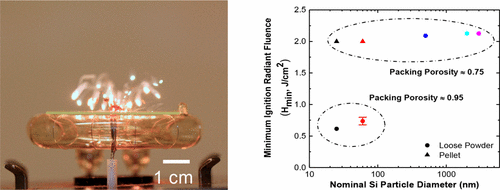当前位置:
X-MOL 学术
›
Nano Lett.
›
论文详情
Our official English website, www.x-mol.net, welcomes your
feedback! (Note: you will need to create a separate account there.)
Facile Thermal and Optical Ignition of Silicon Nanoparticles and Micron Particles
Nano Letters ( IF 9.6 ) Pub Date : 2017-09-11 00:00:00 , DOI: 10.1021/acs.nanolett.7b01754 Sidi Huang 1 , Venkata Sharat Parimi 1 , Sili Deng 1 , Srilakshmi Lingamneni 1 , Xiaolin Zheng 1
Nano Letters ( IF 9.6 ) Pub Date : 2017-09-11 00:00:00 , DOI: 10.1021/acs.nanolett.7b01754 Sidi Huang 1 , Venkata Sharat Parimi 1 , Sili Deng 1 , Srilakshmi Lingamneni 1 , Xiaolin Zheng 1
Affiliation

|
Silicon (Si) particles are widely utilized as high-capacity electrodes for Li-ion batteries, elements for thermoelectric devices, agents for bioimaging and therapy, and many other applications. However, Si particles can ignite and burn in air at elevated temperatures or under intense illumination. This poses potential safety hazards when handling, storing, and utilizing these particles for those applications. In order to avoid the problem of accidental ignition, it is critical to quantify the ignition properties of Si particles such as their sizes and porosities. To do so, we first used differential scanning calorimetry to experimentally determine the reaction onset temperature of Si particles under slow heating rates (∼0.33 K/s). We found that the reaction onset temperature of Si particles increased with the particle diameter from 805 °C at 20–30 nm to 935 °C at 1–5 μm. Then, we used a xenon (Xe) flash lamp to ignite Si particles under fast heating rates (∼103 to 106 K/s) and measured the minimum ignition radiant fluence (i.e., the radiant energy per unit surface area of Si particle beds required for ignition). We found that the measured minimum ignition radiant fluence decreased with decreasing Si particle size and was most sensitive to the porosity of the Si particle bed. These trends for the Xe flash ignition experiments were also confirmed by our one-dimensional unsteady simulation to model the heat transfer process. The quantitative information on Si particle ignition included in this Letter will guide the safe handling, storage, and utilization of Si particles for diverse applications and prevent unwanted fire hazards.
中文翻译:

硅纳米粒子和微米粒子的便捷热和光点火
硅(Si)颗粒被广泛用作锂离子电池的大容量电极,热电设备的元件,生物成像和治疗剂以及许多其他应用。但是,硅颗粒会在高温或强光照射下在空气中点燃并燃烧。在处理,存储和利用这些颗粒用于这些应用时,这构成了潜在的安全隐患。为了避免意外着火的问题,至关重要的是量化Si粒子的着火特性,例如其大小和孔隙率。为此,我们首先使用差示扫描量热法通过实验确定了慢加热速率(约0.33 K / s)下硅颗粒的反应起始温度。我们发现,硅颗粒的反应起始温度随粒径从20–30 nm的805°C到1–5μm的935°C而增加。然后,我们使用氙(Xe)闪光灯在快速加热速率下(〜103至10 6 K / s),并测量了最小点火辐射通量(即,点火所需的Si粒子床的单位表面积的辐射能)。我们发现,所测量的最小点火辐射通量随着Si颗粒尺寸的减小而降低,并且对Si颗粒床的孔隙率最敏感。Xe闪燃实验的这些趋势也通过我们对传热过程进行建模的一维非稳态仿真得到了证实。本信函中包含的有关Si颗粒着火的定量信息将指导Si颗粒在各种应用中的安全处理,储存和利用,并防止不必要的火灾危险。
更新日期:2017-09-11
中文翻译:

硅纳米粒子和微米粒子的便捷热和光点火
硅(Si)颗粒被广泛用作锂离子电池的大容量电极,热电设备的元件,生物成像和治疗剂以及许多其他应用。但是,硅颗粒会在高温或强光照射下在空气中点燃并燃烧。在处理,存储和利用这些颗粒用于这些应用时,这构成了潜在的安全隐患。为了避免意外着火的问题,至关重要的是量化Si粒子的着火特性,例如其大小和孔隙率。为此,我们首先使用差示扫描量热法通过实验确定了慢加热速率(约0.33 K / s)下硅颗粒的反应起始温度。我们发现,硅颗粒的反应起始温度随粒径从20–30 nm的805°C到1–5μm的935°C而增加。然后,我们使用氙(Xe)闪光灯在快速加热速率下(〜103至10 6 K / s),并测量了最小点火辐射通量(即,点火所需的Si粒子床的单位表面积的辐射能)。我们发现,所测量的最小点火辐射通量随着Si颗粒尺寸的减小而降低,并且对Si颗粒床的孔隙率最敏感。Xe闪燃实验的这些趋势也通过我们对传热过程进行建模的一维非稳态仿真得到了证实。本信函中包含的有关Si颗粒着火的定量信息将指导Si颗粒在各种应用中的安全处理,储存和利用,并防止不必要的火灾危险。











































 京公网安备 11010802027423号
京公网安备 11010802027423号